Over the past few months, Sierra Streams Institute has been working with a team of volunteers on a fuels reduction project at Nevada City’s Hirschman’s Pond.
If you were recently walking on the trails at Hirschman’s Pond, you may have seen yellow flagging amidst the trees and heard the sound of chainsaws in the distance. Here’s the scoop behind our work: Sierra Streams is in the final stages of a three-year-long land management project at Hirschman’s Pond funded by the Sierra Nevada Conservancy’s Proposition 1 funding to support healthy forests and watershed work. This project addresses fuels reduction but covers many more bases of restoration. Our goal is to promote healthy forest habitat for humans, wildlife, and the resiliency of the forest and water ecosystems. By removing ladder fuels and reducing the risk of wildfires, we are promoting safety in recreation and housing for people, but also preserving forested habitat for wildlife. Preventing wildfires also reduces risk for increased runoff and sedimentation of a burned landscape, which pollutes our aquatic ecosystems as well. Thinning our forests can actually be healthy for the overall ecosystem, just like weeding a garden. It can create more room for trees to grow and give more access for rain to reach the forest floor and make its way to the awaiting roots of plants.
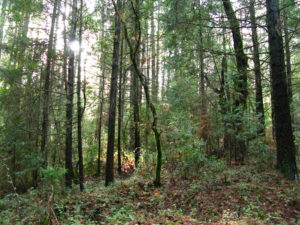
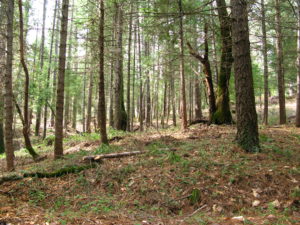
The phase of the project we just completed was removing woody ladder fuels. These included smaller understory trees that were under 6-inch DBH (tree trunk Diameter at measured at Breast Height) along with some fallen or standing dead wood and low hanging branches. One priority was to focus on conserving more deciduous species such as oaks over conifers, which were crowding the understory. Our teams would head out each day, with flagging in hand, to flag trees that were under the 6-inch DBH criteria but we wanted to keep safe from the treatment. Deciding which trees to keep and which trees to remove turned into a bit of an artistic learning experience for all of us. When our team looks at a forested landscape, we see it as it is currently. Then, look at what it has the potential to grow into. We would start from the forest floor and look for saplings, the future generation. We would then move up into the mid and upper canopies and look for crowding. How much of the canopy is covered? Are there any gaps? Do we want to preserve certain saplings to fill these gaps? There is also species composition to consider. Certain microhabitats within the forest promote better success for certain tree species. On one side of a ridge, the incense cedars would look really healthy and resilient and on the other side, the Douglas-firs would be the dominant species. We would look to select trees to preserve species diversity, but also chose trees based on their resilience in a specific area. Promoting the growth of resilient species and species diversity can create an overall more resilient forest community in the face of environmental stressors. Another priority is to prominent wildlife habitat. Certain thickets of climbing honeysuckle and berry-bearing shrubs are essential for wildlife, so these were also areas that we flagged for preservation.
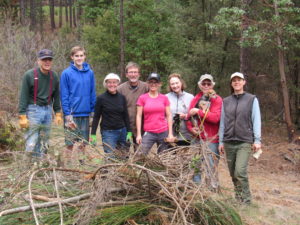
As this project is coming to completion, people are noticing! Mary West in the Auburn Journal states, ” Woods Ravine was a very nice area. It was here that I spotted the massive oak tree. Large pines also dot this trail. The sunlight pierced through the canopy, lighting the trail here, making for some great pictures”. Denise Della Santina, the Sierra Streams Institute project manager, is thrilled that people are noticing. Throughout the project, over 60 acres of forest were thinned of overstocked conifer trees and dead material. If you have a chance to walk the Woods Ravine Trail, take a look around and you may notice a more open understory with less tree crowding, dead fuel, and more potential for forest growth!
Our work is far from over, however. Over the next few months, we transition into removing an even greater source of fuel, the invasive weed called Scotch Broom (Cytisus scoparius). You may notice this green, spindly plant sweeping across large open areas. It has characteristic yellow flowers and brown seed pods that resemble other species in the Pea Family. It is a highly flammable weed that outcompetes native vegetation and is highly prevalent at Hirschman’s Pond. Our first Scotch Broom Challenge of 2018 was held on March 10th and was a huge success! Thank you to our volunteers and the Hirschman’s Fire Safe Community for bringing together refreshments.
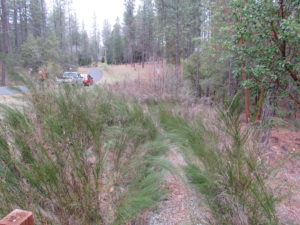
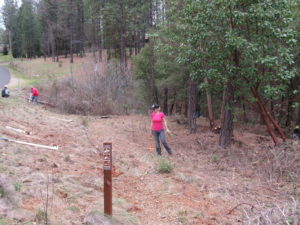
We will be hosting two more Saturday Scotch Broom Challenges from 9am-noon on March 31st and April 7th and welcome any and all help. There will be food and great company along with some very satisfactory weed pulling. In addition, we hope to gather a restoration team for weekday restoration events from 9am-noon on April 18th and 26th and May 23rd and 31st to continue this work. We would like to thank all of our volunteers for their efforts to make our forests a safer and healthier place. So please join us for a community potluck celebration in June to discuss our accomplishments over good food! More details and dates for this event to come.
If you are interested in helping out, please fill out our Volunteer Form and/or email Becca at volunteers@sierrastreamsinstitute.org with any questions and more information on additional work days!

